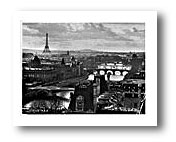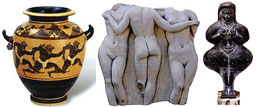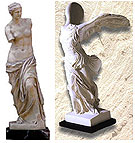
This month we are pleased to present Francois-Auguste-Rene Rodin (Nov. 12, 1840 – Nov. 17, 1917) and consider several influences that shaped his life and his art.
He was born in Paris in 1840 to a Norman father and a mother from Lorraine. They lived very simply. Rodin was schooled in Rouen, 1851-1853. He applied for the sculpture program at Paris’ renowned Ecole des Beaux-Artsbut was rejected three times for sculpture. Later he was offered admission into their drawing program but declined because he felt his future was in sculpture. Being rejected for sculpture is a truly amazing fact considering what Rodin was to become–one of the most pre-eminent sculptors of the 20th century! Having been rejected by Ecole des Beaux-Arts, Rodin instead entered Paris’ decorative arts school, the Petite Ecole, in 1854 at age fourteen. While at this school, he met Jules Dalou (1838-1902), who would become a sculptor-friend. Rodin honored him with a portrait bust in 1883.

Carrying and Pouring an Urn by Pajou
Being a student in Paris had its advantages (see poster below right). Because of the city’s historical significance, he could experience artworks first-hand. One example was the Fountain of the Innocents. Today, this fountain is the last remaining Renaissance fountain in Paris and is decorated with panels by the great French sculptor Augustin Pajou (1730-1809). His panel castings of Female Waterbearers at left were taken by Domenico Brucciani in the 1800s (illustrated below left).

Turn of the century Paris
Rodin refined his art talents under the direction of some of the most renowned mentors and artists of his day. He took art courses under Horace Lecoq de Boisbaudran (1802-1897), learned sculpture from Jean-Baptist Carpeaux(1827-1875) and Albert-Ernest Carrier-Belleuse (1824-1887) (decorative sculptors of France’s Second Empire), and studied in Antoine-Louis Barye’s (1796-1875) anatomy course in the basement of the Musee d’Histoire.
In addition, he studied at the Bibliotheque Imperiale, and the incredible Louvre Museum. All his life, Rodin collected fragments and antiquities; and at the Louvre, he would have seen and studied early Greek pottery and Greek and Mesopotamian fragments.

Greek Athletes Vase, Three Graces, Ishtar
Similarly, Rodin had access to a vast collection of full-sized masterpieces at the Louvre including the Classical Greek Aphrodite of Melos and Hellenistic Greek Winged Victory.

Aphrodite Melos, Winged Nike
With all his exposure to great artwork and influence from respected instructors, it is hard to believe Rodin was not successful before middle age. However, before becoming successful, he struggled primarily with supporting Rose, his son, and parents from 1858 and 1876. To this end, he created decorative stonework in Brussels during 1871-1877 and served as a soldier in France’s National Guard during the months following the collapse of the Napoleon III Empire.
During this difficult period in Rodin’s life, there are three memorable events in 1864 which influenced him. First, his sister died. This event so devastated him, that he entered a sacred order, the Society of the Blessed Sacrament, where fortunately the Father Superior recognized his talents and encouraged him to pursue his art.

Rodin Rose Beuret
That same year, he met a seamstress named Rose Beuret. She became his lifetime companion and modeled for many of his works. A few days before her death in early 1917, she and Rodin were married.
Rodin’s third influential event in 1864 was the creation and submission of his Man with a Broken Nose to the Paris Salon. It was rejected, but eighteen years later in 1882, he redid the piece, had it carved in marble, and submitted it to the Salon. This time it was accepted! Reminiscing in 1887 with Truman H. Bartlett, an American Sculptor, Rodin said, “That mask determined all my future work. It is the first good piece of modeling I ever did. From that time I sought to look all around my work, to draw it well in every respect. I have kept that mask before my mind in everything I have done”. In 1875, Rodin visited Italy. He was especially impressed with Italian Renaissance sculptors Donatello (Donato di Niccolò di Betto Bardi) (1386?-1466) and Michelangelo Buonarroti (1475-1564). Rodin even borrowed from Michelangelo’s “The Slaves”–which are only partially carved out of their marble blocks–in his piece Danaid (illustrated below at left). Notice how the female form is still attached to a mostly uncarved base.
The Italian trip was the turning point of Rodin’s career and the Italian artwork influenced his The Age of Bronze (illustrated above at right), which created a scandal at the Paris Salon in 1877. Critics believed he had used a casting in order to get such a realistic piece.
However, out of this scandal came notoriety and fame and in 1880 he received the commission for the Gates of Hell, a decorative door for the future Museum of Decorative Arts. Although the Gates of Hell was never completed, some of Rodin’s most famous and memorable pieces were originally done for it including Adam, Eve, The Kiss, and The Thinker (illustrated below). He created them in several sizes and exhibited them extensively.

Michelangelo Night and Day, David, Rodin Age of Bronze, Danaid
In his artwork, Rodin deals with all types of human forms and their details. Rodin’s talent is conveying feelings by emphasizing hands and facial expressions. He uses deep hollows to create strong shadows and textured surfaces to catch the subtle variations of light. As a sculptor he also tries to understand the correct distribution of body weight, and to capture a specific human emotion, such as passion.

Rodin Adam, Thinker, Kiss, Eve
We can see his attempt in to express Passion in the Eternal Springtime and Eternal Idol.

Rodin Eternal Springtime, Eternal Idol
In 1916, when Rodin was 76 years old, he gave his entire collection of personal works and other acquired art objects to the French Government. Today, the collection occupies the Hotel Biron in Paris and is known as the Musee Rodin. The sculptures and artwork are still placed as Rodin set them near the end of his life.
Rodin died on Nov. 17, 1917, and was buried at Meudon, Paris, France next to his wife, Rose. The Thinker is nearby. Hardships and struggles, circumstances, and many, many people, especially artists, influenced Rodin. But because of his perseverance, we have many artworks by him today which have become an integral part of the history of Western Civilization. It is hard to imagine not having The Thinker, The Kiss, and so many others which capture the expressive quality of the human form and condition.
Replicas from the our Rodin Collection at Museumize.com
[shopify product=”http://www.museumize.com/collections/artist-rodin-thinker-kiss/products/the-kiss-by-rodin-statue-bronze-finish-parastone-collection-ro12x”%5D
[shopify product=”http://www.museumize.com/collections/artist-rodin-thinker-kiss/products/rose-beuret-in-straw-hat-portrait-statue-by-rodin-ro10″%5D
[shopify product=”http://www.museumize.com/collections/artist-rodin-thinker-kiss/products/the-kiss-statue-replica-kissing-by-auguste-rodin-parastone”%5D
[shopify product=”http://www.museumize.com/collections/artist-rodin-thinker-kiss/products/la-danaide-nude-curled-on-a-rock-statue-by-rodin-ro03″%5D
[shopify product=”http://www.museumize.com/products/david-by-michelangelo-parastone-collection-mic04″%5D